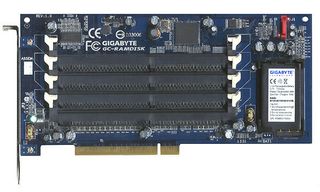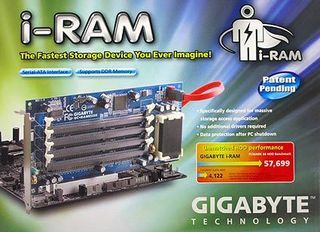Can Gigabyte's i-RAM Replace Existing Hard Drives?
i-RAM In Detail

i-RAM hard disk component designs and how the technology works are relativity straightforward. You take a board that can be plugged into a PCI slot so that it gets power and for the stability provided by the casing. Voltage converters convert the power voltage of the PCI bus (5 or 3.3 volts) into the 2.5 volts needed by the memory modules and the voltages of the remaining components. A simple speed generator from ICS enables the operation of the DDR-DIMMs, for which a total of four sockets are available - more would not be feasible without the use of professional (more expensive) modules with register chips to buffer signals.
In order to finally be able to use the device as a hard disk, a memory controller is needed that at the same time also functions as a serial ATA client. Xilinx supplies the chip for this, but up until now it has not been available in large numbers. Gigabyte is speaking of an initial batch of about 1,000 of the XC3S1000 chips needed for the first i-RAM delivery to wholesalers. Further i-RAM production is contingent on demand.
The serial ATA interface corresponds to the SATA-I standard and delivers an interface data rate of up to 150 MB/s. In practice, just under 130 MB/s is easily achievable. However, we have to wonder why the manufacturer did not demand a solution from the get-go that conforms to SATA-II: Here a bandwidth up to 300 MB/s would be possible and in operation certainly just under 250 MB/s.

Four DIMM sockets accept any DIMMs from DDR266. These can be fitted individually.

It's unfortunate that the lettering on the controller chip could not be better quality. It came out very dark.

The handbook is not very detailed, but it does cover application scenarios and memory modules already validated as well as tips for data protection.

Stay on the Cutting Edge
Join the experts who read Tom's Hardware for the inside track on enthusiast PC tech news — and have for over 25 years. We'll send breaking news and in-depth reviews of CPUs, GPUs, AI, maker hardware and more straight to your inbox.
Current page: i-RAM In Detail
Prev Page i-RAM: Adieu Hard Disk? Next Page Battery To Ward Off Data LossMost Popular


